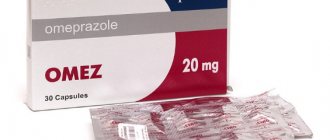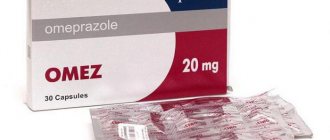"Omez" and "Omeprazole" - what is it?
The purpose of these drugs is to suppress the production of hydrochloric acid by the gastric glands. Why is this suppression necessary? Hydrochloric acid is quite aggressive. When there is a history of gastritis or gastric ulcers, the acid will irritate unhealed wounds on the mucous membrane. If its production is suspended for a while, the shell will have every chance of recovery. Such treatment became possible with the study of proton pump inhibitor drugs, which include Omez or Omeprazole. This article will help you figure out which is better. We will also briefly describe the indications and contraindications, the differences between the drugs.
Description
As already mentioned, omez is an antiulcer agent that belongs to the group of proton pump inhibitors. Its main component is omeprazole, which blocks the last stage of hydrochloric acid production.
Thanks to this action, the level of acid secretion decreases, and this is necessary if a person has an ulcer. The drug is prescribed regardless of what exactly acts as an irritant.
Domperidone acts as an additional element. It performs an antiemetic function, increases the tone of the lower esophageal sphincter, and also has a stimulating effect on peristalsis. Thanks to this, a person empties faster and also feels better.
Experts and patients note that this remedy acts quickly. The effect can be noticed within an hour after administration, and the effect lasts for 24 hours. The active substance is absorbed in the gastrointestinal tract, then processed in the liver and leaves the body through the kidneys. As soon as the medication is discontinued, secretory function will be restored within three days.
Indications:
- Ulcer of the duodenum or stomach, which is in the acute phase.
- Inflammation of the mucous membrane in the esophagus.
- Destruction of spiral-shaped microorganisms in infected patients.
- The presence of a tumor of the islet apparatus in the pancreas.
- The presence of ulcers in the upper gastric tract caused by cirrhosis of the liver.
- Constant proliferation of mast cells that penetrate the organs.
- Preventive measures necessary to prevent recurrence of pathology of the digestive organs.
- Prevention of recurrence of peptic ulcers.
Based on what exactly has been diagnosed in a person, a specific treatment will be prescribed. Please note that there are a number of contraindications for which a person should not use this remedy. These include pregnancy, breastfeeding and childhood. Also, the product should not be used by people who are intolerant to certain components of the drug.
Omez capsules and Omeprazole tablets - what for?
Unfortunately, gastritis and stomach ulcers have become commonplace. The causes of these diseases are hidden both in the unbalanced diet now and in the remnants of the “Union” nutrition standards, when children from one to three months were introduced to complementary foods with juices and cereals completely inappropriate for their age. Then the children’s stomachs coped with the overwhelming load, but nothing just goes away. We have a whole generation with gastritis of various etiologies.
The demand for drugs used to treat these diseases is high, but the supply is not inferior to it.
“Omez” or “Omeprazole” – which is better is difficult to answer, because these are two related drugs intended for the treatment of inflammatory processes of the gastrointestinal tract. They have common indications for use, and side effects are very similar. These are medicines with one active ingredient, but a significant difference in the availability of auxiliary agents.
How the drugs work
Since the products are complete structural analogues, they have the same effect on the body. The active molecule of the drug reduces the acidity of gastric juice, which is used in the treatment and prevention of gastric and duodenal ulcers, erosive gastritis, GERD, reflux esophagitis, and eliminating the negative effects of non-steroidal anti-inflammatory drugs and glucocorticoids on the gastrointestinal mucosa.
Both Omez and Omeprazole inhibit the synthesis of hydrochloric acid. Their action begins in the stomach. The drugs have a cumulative effect. After a day, the medicine forms a film on the gastric mucosa and protects it from harmful influences.
"Omeprazole"
This is a drug that, by its action, interferes with the metabolic process and regulates the production of hydrochloric acid. The active ingredient is omeprazole in an amount of 20 mg.
Indications for use:
- stomach ulcers;
- duodenal ulcer;
- peptic ulcers;
- gastritis with normal and high acidity;
- Zollinger-Ellison syndrome (ulcer combined with benign neoplasms of the pancreas).
Active substance
Omeprazole and Omez work similarly and have the same release form - capsules. The active substance, omeprazole, enters the stomach. By combining with an acidic environment, it suppresses its effect, thereby helping to reduce the production of gastric juice. When acidity normalizes, the mucous membrane of the organ becomes covered as if with a protective film. During this time, she “rests” and recovers.
Both drugs are absolutely identical, available in the same dosages, but there are some differences. The first difference lies in the manufacturer. The omeprazole molecule is in demand on the pharmaceutical market, so Omez has a huge number of analogs for the active substance. The difference in this case is only in the name.
The second difference is the price. The pricing policy for a particular drug that contains omeprazole depends on the raw materials used in the manufacture of the drug. In addition, the cost is affected by the amount of excipients in the drug.
The result of taking the active ingredient is noticeable within the next day.
"Omez." Briefly about the drug
"Omez" is a drug that affects the functioning of the proton pump. Active ingredient: omeprazole, 20 mg per capsule plus excipients. The components of the medicine are contained in granules that are resistant to acids. That is, the drug dissolves and begins to act in the intestines, and not in the stomach, which enhances its effect. The drug is used in the cases described above. But, in addition to the mentioned effects, taking Omez also significantly reduces stomach acidity and relieves heartburn. The drug is effective for about 24 hours; in uncomplicated cases, taking one capsule per day is sufficient. The drug is effective in the fight against Helicobacter bacteria. The drug is contraindicated during pregnancy and lactation; with some exceptions, treatment of children under 12 years of age is unacceptable.
Release form
Despite the difference between Omez and Omeprazole in the presence of additional components, the dosage of the main active ingredient in their composition is the same.
Omez capsules are hard, made of gelatin, with a transparent body and a pink cap. The capsule bears the inscription “OMEZ”. The contents of the capsules are white granular spherical powder containing the main active ingredient and auxiliary components.
Omeprazole capsules are hard capsules made of gelatin, with a white body and a red cap. Each capsule contains a granular spherical powder from white to light beige color, containing the main active ingredient and auxiliary components.
The dosages of the main active ingredient in these analogues are 10, 20 and 40 mg. Capsules are packaged in contour packaging of 10 pieces.
"Omez" and "Omeprazole": the difference
In 1989, the Swedish pharmaceutical company Astra released the drug Losek. It became practically the first proton pump inhibitor drug. Despite its considerable price, the drug quickly sold out. Many pharmaceutical drug manufacturing companies have followed the well-trodden path and released their analogues - “Helol”, “Omeprazole”, “Omez”, “Omitox”, etc. Now these drugs are called the English term “generic”.
What is a generic? This name comes from English and is literally translated as “generic, generic.” This word refers to drugs that are analogues of patented drugs, the effect of which has already been proven and tested. The license for such drugs is valid for a limited time, and after its expiration, many pharmaceutical companies begin to produce their drugs under the most similar name with the addition/subtraction of letters or numbers. These are generics. Now there are many of them on the pharmaceutical market.
The common substance of the drugs is omeprazole. “Omez” and “Omeprazole” - the difference between these drugs is in price and additional auxiliary substances.
Thus, Omez is a generic version of Loseca, and Omeprazole is a generic version of Omeza.
What is the difference between Omez and Omeprazole? The first drug is produced in India, the second in Russia. “Omeprazole” represents the active substance in the maximum volume, while “Omez” is a drug that contains omeprazole and excipients that mitigate side effects and help the perception of the medicine.
What do the experts say?
Both products are generics of the drug Losek, which was released back in 1989 in Sweden. Thus, they are created on the basis of the original product, but they differ in purification, the composition of additional substances, and they want to completely replace it in terms of the main component.
According to gastroenterologist Natalya Antipova, it cannot be said that Omez is more effective than Omeprazole in terms of therapeutic effects.
Both remedies work at the same speed, have a prolonged effect, and are excellent for gastritis and other hypersecretory diseases.
The difference is great in the degree of purification, the quality of production of the main component, and the set of additional substances, therefore Omez has a lower risk of side effects.
If we compare the severity of unpleasant effects, even with the same list of cheaper products, they are more serious. Thus, nausea occurs when taking Omez much less frequently than when treating with Omeprozole. Moreover, there is Omez-DSR, which contains domperidone, an antiemetic component. It can be taken if the patient has such reactions. The list of auxiliary components of the Indian product is more precise; they are more expensive, which affects the price. But the danger of developing negative actions from the product is minimized as much as possible.
Reviews about "Omez"
What to choose – “Omez” or “Omeprazole”? Reviews will help you figure it out. “Omez” has been the flagship drug on the market for the treatment of gastritis for quite a long time. Unfortunately, many people have this disease, so medications are in demand. Based on an independent survey conducted on social networks among those taking the drug, we can come to the conclusion that it is effective. There is almost always a result. Another thing is side effects. The list is quite long, but if you have to take a drug that interferes with metabolism at a serious level, then you cannot do without side effects. As a remedy that helps restore the gastric mucosa, relieving symptoms and pain in gastrointestinal diseases, Omez has proven itself well among patients.
Therapeutic interchangeability: original drug or analogue
In fact, the first drug made on the basis of omeprazole and shown to work well in the treatment of stomach medications is Losek (Astra). This product first appeared on the pharmaceutical market in 1989. Due to its excellent clinical characteristics, other manufacturers began producing similar but cheaper generic drugs. Therefore, it is definitely quite difficult to say right away which is better than Omez or Omeprazole, since both of these drugs are analogues of the expensive Losek.
However, the price between the antiulcer analogue drugs themselves can also vary significantly. Since Omez is a product of the Indian pharmaceutical industry, it will accordingly be more expensive than Russian Omeprazole.
Reviews about Omeprazole
Not everyone knows about such a drug as Omeprazole. Patients often return from a gastroenterologist with a prescription for Omez. But you should not immediately accuse doctors of colluding with pharmaceutical components that are not in Omeprazole. According to the general reviews of the patients surveyed, the majority noted the effectiveness of the drug. But there are also complaints about side effects, such as:
- nausea;
- feeling of heaviness and discomfort;
- dry mouth and changes in taste;
- diarrhea or constipation.
Negative consequences in terms of general well-being were also noted:
- heaviness in the muscles;
- dizziness;
- insomnia or constant desire to sleep;
- depression;
- mood swings;
- changes in vision, negative non-negotiable processes are possible.
The drug is contraindicated during pregnancy and breastfeeding. In childhood, use is permissible only in the case of Zollinger-Ellison syndrome. It is worth saying that these side effects are also listed in the Omeza instructions, but in reality they are less common and less pronounced. This may be due to the higher degree of purification of the drug and its production processes.
What is the difference between Omez and Omeprazole?
Stomach problems are considered the most common diseases today, affecting people of all ages. Poor ecology, poor diet with excess fatty, heavy foods in the diet, excess stress - all these risk factors lead to the fact that people of all nationalities and social classes suffer from gastric diseases.
Fortunately, almost all of these diseases can be successfully treated with modern medicine. However, the abundance of medicines has a big drawback - it’s easy to get confused about which analogue to choose.
Omeprazole occupies one of the leading positions in popularity in the list of antiulcer drugs. The analogue “Omez” is not far behind it. What is the difference between these two drugs and can we say that Omeprazole is definitely better than Omez or vice versa? Let's try to figure it out below.
Brief information about Omeprazole
This drug from the group of antiulcer drugs belongs to proton pump inhibitors. In other words, Omeprazole, when entering the human body, affects the cells of the gastric mucosa, which are responsible for the production of hydrochloric acid, and suppresses their work. Thus, acid secretion is significantly reduced and acidity levels drop.
In addition, Omeprazole has a neutralizing effect on gastric juice, reducing its acidity. All this creates favorable conditions for the healing of wounds and erosions, as well as for more effective antibiotics if the ulcer was caused by Helicobacter pylori bacteria.
Indications for the use of Omeprazole are the following diseases:
- Gastric and duodenal ulcers, both in the acute stage and for the prevention of relapse;
- Reflux exophagitis;
- Zollinger-Ellison syndrome;
- Gastropathy caused by taking medications;
Contraindications to taking the drug are:
- Pregnancy and breastfeeding period;
- Childhood;
- Hypersensitivity to the components of the drug;
- The drug should be taken with caution in patients suffering from renal or liver failure.
Manufacturer and price
As mentioned above, Omez is produced in India, its price is about 150-200 rubles per package. Omeprazole is represented on the market by several manufacturers, including Russian pharmaceutical companies, and also produced in Israel and Serbia. The price ranges from 50-100 rubles per package.
Supplements
Omeprazole contains the maximum amount of active ingredient with a minimum of additives. Omez contains a large number of excipients, which, on the one hand, mitigate side effects, on the other hand, reduce the cost of the production process and slow down the achievement of the maximum concentration of omeprazole.
Time of action
Omeprazole reaches its maximum effectiveness in about half an hour to an hour after administration, depending on the individual characteristics of the human body. Omez begins to act a little slower, an hour after ingestion. The effect of both drugs lasts the same time - twenty-four hours after administration, which significantly simplifies the dosage regimen.
Indications for use
- peptic ulcer of the stomach and duodenum, including those caused by taking medications, Helicobacter pylori bacteria, stress;
- Gastroesophageal reflux disease;
- Pancreatic adenoma is ulcerogenic;
- Systemic mastocytosis.
The list of diseases for which Omez should be used also includes pancreatitis. This does not mean, however, that Omeprazole is not used in the treatment of pancreatitis, on the contrary. But the fact is that in order to include a new disease in the list of indications for use, expensive research is required, which is not always profitable for pharmaceutical companies. Therefore, although Omeprazole is successfully used in practice in the complex treatment of pancreatitis, there is no information about this in the instructions.
Release form
"Omeprazole" is available in the form of capsules of various dosages (20, 40 mg are available).
"Omez" also comes in the form of enteric capsules (dosage 10, 20, 40 mg) and powder for infusion (40 mg).
Obviously, the variety of forms of Omez puts it in a more advantageous position compared to Omeprazole, because this way it will be easier for the doctor to choose the most appropriate dose for the patient.
Dosage
When treating with both Omez and Omeprazole, the required dose is determined by the doctor, based on their diagnosis, health status and characteristics such as weight, gender and age of the patient. The maximum dose that can be prescribed to patients with Zollinger-Ellison syndrome is 120 mg per day; in this situation, repeated doses of omeprazole are prescribed (two to three times a day).
If you refer to the instructions for use, there is no data on an overdose of the drug. It was indicated that taking a dose of more than 160 mg of omeprazole did not threaten the patient’s life.
We also note that antiulcer drugs are available at the pharmacy by prescription, so it is strictly not recommended to independently change the dosage prescribed by the doctor.
Contraindications
Both drugs should not be taken if there is an allergy to one of the components of the drug, or for children under four years of age (up to the age of fourteen, the decision to prescribe the drug must be made by the attending physician, and is due to the patient’s serious illness). Medications are not recommended during pregnancy and breastfeeding.
The expectant mother may be prescribed Omez or Omeprazole if the risk to her health is higher than the potential threat to the baby. According to the international classification, both drugs belong to category “C” of danger to the fetus, which means a proven negative effect on animal embryos in the absence of official studies on humans.
You may find it useful: What is the difference between Omeprazole and Nolpaza?
Side effects
The list of possible negative effects on the body for both drugs is quite wide, but most of them occur in less than 0.1% of cases.
As a rule, all negative effects are reversible and go away on their own immediately after stopping the drug.
Relatively common side effects (less than 10% of cases) include: headache, bowel dysfunction (diarrhea, constipation), nausea, abdominal pain.
In less than 1% of cases, the following were observed: insomnia, malaise, dizziness, increased drowsiness, skin manifestations of allergies (itching, rash, etc.), increased activity of liver enzymes. That is why those who suffer from any pathologies of the kidneys and liver should be very careful, since taking proton pump inhibitors creates additional stress on these organs.
To summarize, is it possible to say that one of the drugs is better? Hardly. Both have a number of advantages and disadvantages. If we talk about cost, then Omeprazole wins here, which costs half as much as Omez. As for the dosage and the presence of excipients, everyone decides for themselves what would be more convenient for them.
In any case, a conversation about what would be best to take in a given individual case should be conducted with the treating gastroenterologist. It is he who will advise, based on the patient’s test data, which medicine is best for him.
Source: https://omeprinfo.ru/analogi/chem-otlichaetsya-omez-ot-omeprazola.html
Comparison of drugs
In order to be as objective as possible and find out which is better - Omez or Omeprazole, we will compare medications according to pharmacological and economic parameters.
Price
Omez is an Indian-made drug that costs about 200 rubles on average.
Generic Omeprazole is produced by foreign and domestic manufacturers.
The cheapest medicine is produced in Russia and costs about 40 rubles.
The average cost of imported Omeprazole is 130 rubles.
Quality
Despite the obvious price advantage of the domestic product, you should not chase savings - it is better to give preference to Omeprazole in the middle price category. After all, the quality of the drug substance depends on the cost - drugs with a higher price have better purification and less impact on the liver.
Indications and contraindications for use
It is precisely because of poor purification that inexpensive Omeprazole is contraindicated for liver diseases, while the instructions for Omez do not contain such a restriction on taking the medicine - use is permitted with caution on the recommendation of a doctor.
A cheap analogue of Omez is contraindicated for children, nursing and pregnant women, while the original drug is allowed to be used in pediatrics (in patients weighing more than 20 kg), nursing women and expectant mothers (with the permission of a doctor). Clinical studies have not revealed any negative effects on the health of the mother and offspring. By the way, Omeprazole has not undergone clinical trials at all.
Omez is a well-known drug in Russia, both by doctors and patients. Often found in the treatment of various stomach diseases. Despite the fact that, guided by the instructions for use, the annotation indicates peptic ulcer disease, it is also prescribed in combination for other gastrointestinal ailments associated with high acidity, for example, heartburn.
Omez or Ranitidine – which is better, what is the difference
Manufacturer: Ozone, Russia
Release form: tablets
Active ingredient: Ranitidine
Synonyms: Gistak, Zantac, Rantak, Ranitidine-AKOS, Ranitidine-Acri
Ranitidine, a cheap analogue of Omez in tablets, blocks the secretion of gastric juice using a different mechanism of action - it inhibits specific histamine H2 receptors, which leads to a decrease in acidity.
In addition, the medication improves the barrier function of the gastric mucosa, stimulates the healing of the ulcer surface, and increases the production of gastric mucus.
The analogue Ranitidine is prescribed in doses higher than Omez - 150-300 mg for the same diseases and additionally for gastric bleeding.
Omez or Almagel - which is better?
Manufacturer: Balkanfarma, Bulgaria
Release form: suspension for oral administration
Active ingredient: Algeldrate + Magnesium hydroxide
An analogue of Omez for the stomach, Almagel is an antacid drug that does not reduce acid production, but neutralizes what has already been released. Therefore, the remedy does not need to be used constantly, but only periodically, when symptoms appear from time to time and are not the cause of an internal disease, but arise due to poor nutrition.
The drug is prescribed in the first days of the disease, when etiological treatment has not yet brought results.
There are varieties of the drug containing additional components. Thus, Almagel A contains a local anesthetic, which promotes rapid pain relief. Almagel Neo contains Simethicone, which helps with excess gas formation.
In what situations is the use of Omeprazole justified?
As for Omeprazole, its use may be conditional upon detection of gastric ulcer
, or the duodenum. Often this drug is also used for erosive and ulcerative lesions of the stomach or for Zollinger syndrome, which is especially relevant now!
Omeprazole is necessary to protect the stomach when taking anti-inflammatory drugs that are non-steroidal in nature. In particular, this state of affairs should apply to those that cause an irritating effect on the mucous membrane of the human stomach, as well as those that could cause the formation of various erosions or acute ulcers.
If we talk about the most significant differences between both of these drugs, it should be noted that Omez is a product that simply contains Omeprazole, while Omeprazole itself implies a full- fledged active substance
.
Their effectiveness can hardly be considered identical, since Omez acts as a non-original, so-called similar medicine, which will require a much longer amount of time to reach its highest concentration. Moreover, this analogue is eliminated from the human body more quickly, which does not have the most positive effect on its effectiveness. In any case, and especially taking into account the fact that Omez is much cheaper than Omeprazole, in some situations, the use of such an analogue of the original drug may also be considered acceptable!
To treat gastrointestinal diseases, drugs from different pharmacological groups are used. Some medications are similar in their mechanism of action or are analogues of more expensive or unavailable medications. Therefore, the doctor sometimes has to choose which drug to prescribe - for example, Omeprazole or Omez.
Let's find out what is better than Omez or Omeprazole, what is the difference between them and whether they are interchangeable drugs.
So: Omez or Omeprazole – which is better, the opinion of experts in the field of pharmacology.
The medicine belongs to the category of medications that reduce excessive secretion of the gastric glands, responsible for maintaining the physiological pH level of the environment and the synthesis of hydrochloric acid.
Inhibition occurs as a result of an effect on the enzyme system - the proton pump.
Several dosage forms are available:
Once in the stomach, Omez, under the influence of an acidic environment, is activated and blocks an enzyme called the “proton pump” (or pump). Due to this, the production of hydrochloric acid decreases, and, as a result, the acidity level returns to normal.
The traumatic effect of an aggressive internal environment on the condition of the mucous membrane of the digestive tract is reduced. Erosions and ulcers heal faster, and the likelihood of internal bleeding is reduced.
The medication inhibits the activity of Helicobacter pylori bacteria and increases the effectiveness of anti-Helicobacter therapy using antibiotics.
The indicated pharmacological properties have a positive effect on the health of the digestive organs in patients diagnosed with:
- gastritis;
- erosion;
- ulcer of the duodenum and stomach;
- gastropathy caused by taking gastrotoxic medications - analgesics, hormones;
- systemic mastocytosis;
- reflux esophagitis disease;
- polyendocrine adenomatosis.
Used as a prophylactic:
- in surgical practice (to avoid postoperative complications - aspiration pneumonitis);
- when taking NSAIDs.
It can be used in pediatric practice for patients weighing more than 20 kg in the treatment of reflux and peptic ulcer disease combined with Helicobacter pylori infection.
If prescribed by a doctor, it can be used in nursing women and expectant mothers. If you are intolerant to any ingredient, you should not take the medicine.
The frequency of use depends on the established diagnosis and dosage and averages 1-2 times a day.
The duration of therapy is determined individually:
- with an irradiation treatment regimen – 7-10 days;
- as an independent remedy - at least 1 month;
- in surgery it is taken once.
For pathologies of the liver and kidneys, no dose adjustment is required.
The most common side effects are dyspeptic symptoms (discomfort and abdominal pain, stool problems, nausea). With prolonged use, it worsens mineral metabolism and can provoke the appearance of osteoporosis.
What is better to buy, Nolpaza or Omez
Nolpaza is a fairly popular drug that is used for stomach pain and heartburn. It is often used when a person has chronic gastritis or an ulcer.
However, the average person may not know which is better, Nolpaza or Omez. Therefore, you should consider these drugs, and then no questions will arise.
These drugs have common indications, because their main function is to suppress the production of hydrochloric acid. The drugs are used for gastritis, ulcerative pathologies, as well as in case of Helicobacter pylori infection. The result can be noticed immediately after a person takes the drug. Both products can be used half an hour before meals, and more than 40 mg per day should not be used.
Nolpaza and omeza also have differences. First of all, they lie in the active components that make up the medicine. Nolpase contains pantoprazole, and another drug contains omeprazole.
The analogue is produced in Europe, directly in Slovenia. As you know, omez is produced in India.
Note that Nolpaza is well absorbed and has a gentler effect on the gastrointestinal tract, so there is less risk of experiencing side effects.
However, this remedy is more suitable for prevention, because it can be taken for a long time. People may be upset that Nolpaza is more expensive, because its price starts from 200 rubles and above. It makes sense to purchase it when a person can afford it and wants to achieve the best effect.
Characteristics of Omeprazole Akrikhin
Omeprazole-Akrikhin is available in 20 mg capsules. In addition to the active substance, the medicine also contains:
- mannitol,
- sodium lauryl sulfate,
- lactose,
- diethyl phthalate,
- methacrylic acid copolymer,
- povidone,
- calcium carbonate,
- propylene glycol,
- polysorbate,
- sodium hydrogen phosphate,
- hypromellose,
- sucrose,
- sodium hydroxide,
- cetyl alcohol,
- titanium dioxide
The composition inside the capsules is represented by white or yellow granules.
The drug is prescribed in the following cases:
- in the treatment of reflux esophagitis,
- in the treatment of stomach ulcers, duodenal ulcers,
- in the treatment of gastrointestinal ulcers acquired due to stress,
- for the treatment of tumors in the endocrine glands,
- in the treatment of gastropathy that occurs after treatment with NSAIDs,
- in the treatment of pancreatic adenoma and gastrinoma,
- to destroy Helicobacter pylori in patients with complex forms,
- to eliminate thermal or chemical burns of the esophagus,
- in the treatment of systemic mastocytosis,
- to eliminate flatulence.
The medication is also prescribed as part of complex treatment for children.
The active component of the drug reduces the production of hydrogen chloride in the stomach by blocking thermogenin in the mucosa, which transfers protons across the membrane. Due to this action, the occurrence of hydrogen chloride is reduced, regardless of what causes it.
After taking even one tablet, acidity normalizes within 0.5-3.5 hours, and the patient’s well-being becomes better.
Pharmacists promise that after 4 days the drug will reach its maximum effect, which is lost just as quickly after stopping use.
Omez's analogs
Omez can be replaced with different drugs, the choice depends on the diagnosis.
Numerous analogues and substitutes for Omez are divided into groups:
- Synonyms containing Omeprazole are Losek MAPS, Omizak, Omitox, Ulcaps.
- Other proton pump inhibitors are Lancid, Nexium, Emanera, Pariet, Nolpaza.
- H2-histamine receptor blockers - Kvamatel, Famotidine, Ranitidine.
- Antacids - Phosphalugel, Rennie, Gastal, Almagel, Maalox.
- Enzymes that improve digestion - Mezim forte, Pancreatin, Creon, Festal.
- Other drugs used to treat the gastrointestinal tract are Trimedat, Espumisan, Domperidone, Linex, Acipol, Rebagit, Ganaton.
Prices for Omez analogues are presented in the table.
| Analogue | Active substance | Average price for the minimum course, rub. | Manufacturer country |
| Omez | Omeprazole | 90 | India |
| Omeprazole | 50 | Russia | |
| Ultop | 150 | Slovenia | |
| Omez D | Omeprazole + Domperidone | 200 | India |
| Omez DSR | 200 | ||
| Ranitidine | Ranitidine | 50 | Russia |
| Nolpaza | Pantoprazole | 150 | Slovenia |
| Almagel | Algeldrate + Magnesium hydroxide | 120 | Bulgaria |
| Rabeprazole | Rabeprazole | 150 | Russia |
| Pariet | 1000 | Japan/Switzerland | |
| Razo | 220 | India | |
| Khairabesol | 270 | India | |
| Emanera | Esomeprazole | 120 | Slovenia |
| De-nol | Bismuth tripotassium dicitrate | 800 | Netherlands |
| Rebagit | Rebamipide | 700 | Czech |











